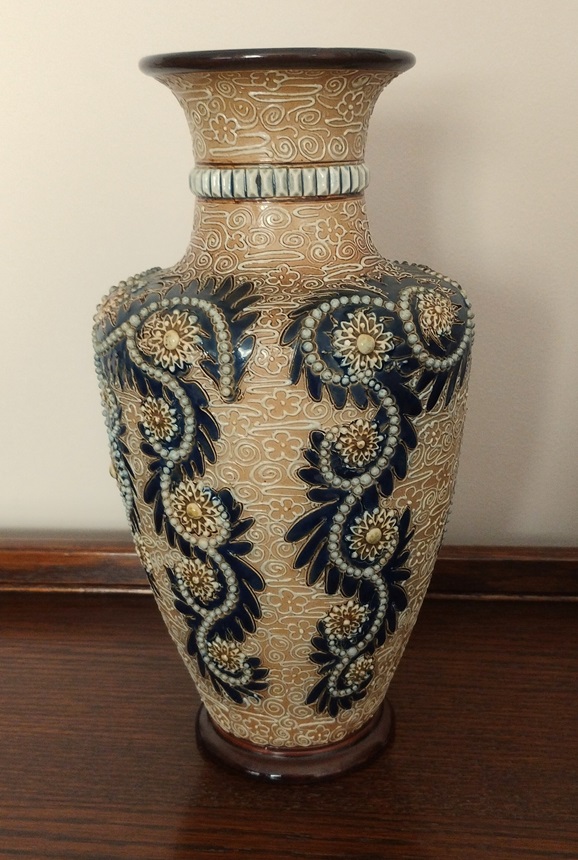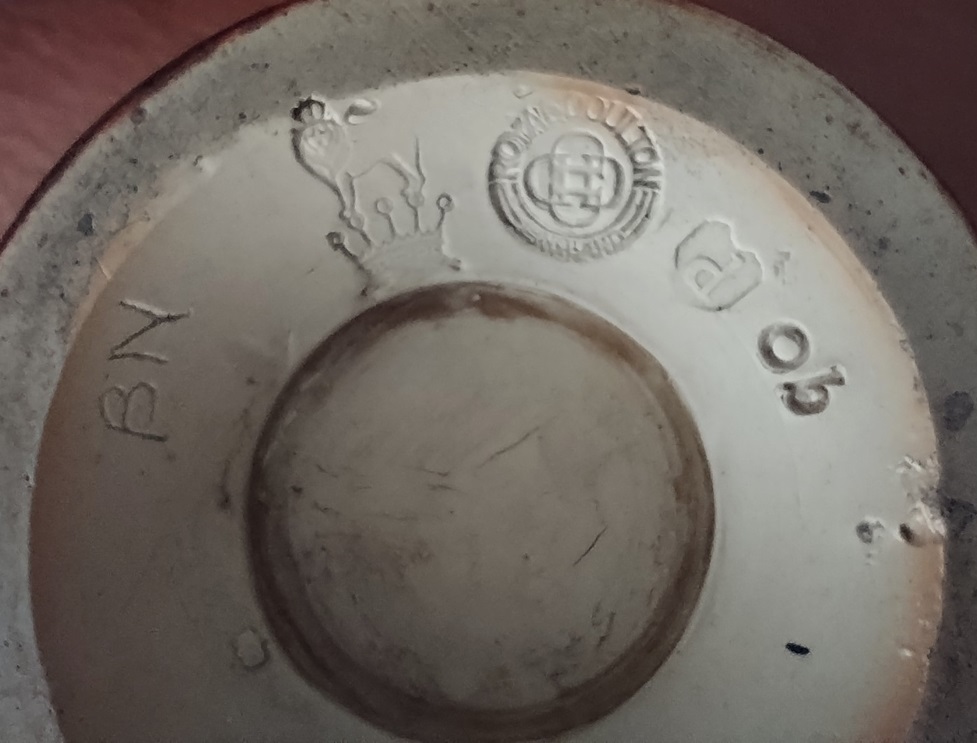
George Tinworth: A rather forgotten life
George Tinworth was the first (and probably the best known) of the ceramic artists to be employed by the Doulton Pottery in the late 19th Century. In his lifetime, Tinworth was best known as a sculptor and designer of terracotta panels depicting religious scenes and it was these that first brought him to prominence in the 1880s.
From a very humble background, Tinworth’s his rise to fame (but never fortune) is a story worth learning and it’s a pity that no full biography has ever been written. The best summary of Tinworth’s life that I have found is by Miranda Goodby, which can be found on the Tiles & Architectural Ceramics Society web site. However, with just a little research, you can unearth other snippets of interest. It seems lots of admirers of his work have written something but no one has taken on the challenge of doing the job properly. I guess I’m adding to that former group! Tinworth himself began writing an autobiography although it seems his skills as a ceramicist were vastly greater than his skills as a writer. “The Doulton Lambeth Wares” by Eyles and Irvine present photographs of a couple of the surviving pages. If you look these up, you’ll see that a completed work would have been hard to achieve without a ghost writer, or at least a great deal of assistance.
By the end of Tinworth’s career, his style of sculpture had gone out of favour and he seems to have become frustrated that he failed to retain the critical acclaim of his early years. In the class ridden art circles of 1920s Britain, his lowly background counted against him as well. His obituaries were short and rather mean spirited describing his work as rustic and naive. A hundred years on, Tinworth’s contribution to art ceramics is more easily appreciated, but it’s still easy to feel justice wasn’t done at the time. Without Tinworth’s early genius, Henry Doulton may never have been willing to fund what became Royal Doulton’s art ceramics studios and artists such as Hannah and Florence Barlow, Frank Butler, and Mark Marshall may never have got a chance. My sideboard would look very different!
A legacy that continues to inspire
Since his death, whilst Tinworth’s religious works have never regained their original popularity, his name shines brightly in the sale rooms of the world whenever his other pieces of work come up for sale. Top of this list are the gorgeous, humorous groups of frogs and mice, posed in very human-like settings. Usually described as place card holders, these groups sell for far more than their size would suggest. For me, top of the bill goes to the chess sets of mice characters. I’ve seen one in the flesh but I fear a full set will remain something I could only dream of owning. I may open the piggy bank for “Teatime scandal” or “The Play Goers” at some stage. If you’re not familiar with these, have a look for them.
The other area of Tinworth’s work that often comes up for sale are his stoneware vases. These vases are often adorned with seaweed-like patterns in the blue and brown glazes common to other Doulton stoneware of the era. From a distance the patterns look simple but, like the fractal geometry that they also recall, on close inspection the patterns are complex and rarely repeat.
A Tinworth vase, a dream of ownership
I’ve long wanted one of Tinworth’s seaweed vases. We don’t have display space for a large collection of anything in particular so I need to be choosy. As usual, I’d been out bid at auction a couple of times on pieces I liked but when this one came up for sale I decided it was time to dig my heals in. I was passing Potteries Auction a couple of days before the vase went under the hammer, so I was fortunate to be able to view it in person. As it turned out, the hammer fell close to the low estimate and I was able to secure the vase within my budget. I should also offer a little Thank You to Potteries Auction for doing an excellent job of posting the vase on to me for a very reasonable amount.
In a large auction room, surrounded by dozens of other (generally) desirable things, it can be hard to isolate an item you’re interested in from what’s around you. I often think you could do with a small viewing area to take things to admire them without being distracted; a place that has the scale of a domestic space rather than, as is often the case in sale rooms, a factory unit. Some decent lighting would often help. Without that, the result is that when you get your items home, and see them in your own environment, they appear to grow and it’s only then that you get to really appreciate their true beauty.
The joy of ownership

The vase is about 10 inches high (I would usually use metric measurements but it seems appropriate for an object made in Britain 130 years ago to use Imperial measurements). I’m drawn to vases about this size. They have a bit of gravitas without being dominant in a room. Being stoneware, and quite thick walled, the vase is also noticeably heavy when you pick it up. The textured surface is far from smooth so it’s a very different experience to holding say a piece of fine porcelain finished with multiple layers of smooth glaze. You get the sense of a quite solid, almost rustic item and yet the complexity of the design shows it to be of sophisticated craftsmanship.
The rather angular, shouldered form of the vase provides a bigger surface area for the pattern when viewed from above. However the design avoids being awkward in appearance, an issue that I find with some Doulton stoneware where I suspect the designers were pushing boundaries simply to try to produce something a bit different. For me the vase is both pleasing to look at and is very tactile. I don’t regret being prepared to fight for this one, but I’m glad no one else was feeling the same.

The surface design consists of a mixture of applied and incised decoration. The “seaweed” pattern is incised whilst the flowers and dots are applied separately. The intermediate filling of white lines depicting flowers and swirls appears to be simple tube lining, but with no infill. In later years Doulton used in-filled tube-lining to great effect producing some wonderful pieces of Art Nouveau pottery. I love these and have found them to be very easy to find a buyer for when I try to sell. The masters of tube-lined ceramics are of course Moorcroft and indeed William Moorcroft was starting to make a name for himself around the same time.
The makers leave their legacy
Although many Doulton vases were produced to a pattern, this one has no pattern number on the base and as such we can assume it is a one off. One off vases were hand thrown whilst volume produced items were sometimes slip-cast. Both the designer and the artist often left their marks on one off items. Generally, artists’ marks and monograms are to be found on the base of vases.

Unusually George Tinworth was permitted to sign his work on the outside where his monogram is more visible. It’s often said (and blindly repeated) that at Doulton, this was a privilege granted to only Tinworth. However, I have recently seen a vase in an auction room designed by Hannah Barlow where her monogram was also on the outside. This indicates that Hannah Barlow was viewed as sufficiently deserving of the same privilege. It also proves you shouldn’t believe everything you read. I wish I’d photograph the vase!
Interpreting the basal marks

The base of the vase can tell us some more about its production, or at least it can when you sit with a copy of Eyles and Irvine next to you, for which I can thank for the following:
- The lion over the crown and the Royal Doulton marks indicate production from 1902 onwards.
- The lowercase “d” in the shield probably indicates production in 1903 (“c” was 1902 and a new letter was used each year from there). Tinworth died in 1913 so this dates falls well within his lifetime, which is always worth checking!
- The initials “BN” relate to Bessie Newbury who worked for 42 years at Doulton, from 1882 to 1924. As she apparently often appears to have worked on pieces by Tinworth. I think it’s to be assumed she was very highly regarded as an artist and apparently in her final decade at Doulton designed works of her own.
- The letters “ob” are a puzzle. If they relate to an artist then that would be Emma Burrows. Apparently, Emma was an assistant artist between 1881 and c1894. This presents a paradox because, if nothing else, Edward VII granted the Royal Warrant (allowing Doulton to become Royal Doulton) in 1901. There are also rather more pieces of Doulton stoneware around with the “ob” mark than you would expect from someone who worked for thirteen years. Apparently, there were around 450 people who left marks on Doulton art ceramics, so you’re in good company. So, until I’m corrected, my guess is this mark is an indication of some production information such as the type type of clay mixture used. I also notice that, unusually for an artist’s mark, the letters appear impressed rather than incised (by hand). Doulton art ceramics with impressed marks (other that name/date marks) are mentioned in a few places but I’ve not seen a detailed reference (appendix 3 of Eyles and Irvine gives a few examples). If my guess (and it is only a guess) is correct then a good number of pieces going through auctions listed on the internet have been wrongly attributed to Ms. Burrows. The alternative is that she was working for Doulton into the early 20th century and Eyles and Irvine are selling her short.
Post script: The start of a lifelong friendship
I’d like to finish with a short quote from “The Martin Brothers Potters” by Malcom Haslam, which I happen to be reading at the moment (it’s excellent). When I came across this passage it stopped me in my tracks. It begins by talking about (Robert) Wallace Martin, the most well known of the Martin Brothers and creator the famous and now very, very expensive “Wally Birds”:
His closest friend among the Lambeth Students was probably George Tinworth, a wheel-wright’s son who joined Wallace’s class shortly after the school had opened at the new building. Tinworth often walked home with Wallace and used to stay for supper at the Martins’. Fifty years later he would remember Wallace’s parents as “splendid people”.
Can you imagine sitting down for supper with these two young men? I wonder what they talked about? I wonder if they dreamed of recognition and success? Tinworth gained achieved both in his lifetime, but Wallace only saw the first real signs at the very end of his days. I feel honoured to own modest examples of both their work.